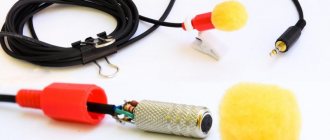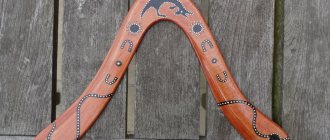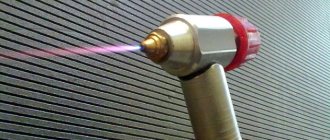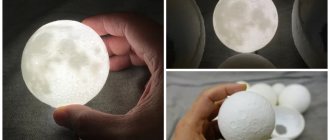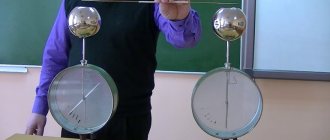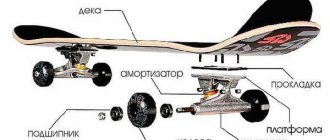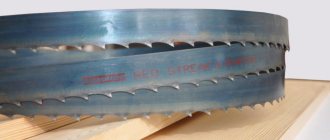To watch movies and images, you can create not only a simple projector for your phone with your own hands, advertising logos, but also more complex designs using spare parts from electronics, ready-made control modules. The picture of a primitive homemade product will be a little blurry, but this will be enough for watching feature films. And if you approach the assembly thoroughly and create an LED projector, then in terms of functionality it will be comparable to factory models and at the same time will be several times cheaper.
What is needed for this
First, let's look at the operating principle of such equipment. The main structural elements are lenses and lens. The quality of light flux distribution on a large screen depends on them. The main thing is to set the correct angle. In the absence of initial technical data regarding the lens and lenses, the correct distance between elements can be established by trial and error.
The image source in our case is a liquid crystal matrix. You can use both a part from a monitor and a smartphone. In the first case, the image will be much sharper and better overall because the area of the sensor is critical. The best option is FullHD scanning - 1920 x 1080 pixels.
The brightness of the projection lamp plays a significant role. The brighter it is, the larger the output area it covers. Simply put, it is a measure of the final screen size.
Idea N1 – Halogen to the rescue
The simplest option is not to reinvent the wheel from scratch, but to use an old or burnt-out lighting lamp as a base. Among the wide variety of lighting equipment, halogen light bulbs are quite common. In everyday life, their models with G and GU pin bases are especially popular, so we will look at the manufacture of an LED lamp using the example of such a lamp.
To work you will need the following elements:
- LEDs provide luminous flux; the power of a homemade light bulb will depend on their technical characteristics. For these purposes, it is desirable to have identical LED elements, as this will simplify the calculation and the principle of their connection.
- Resistors - in case you need to limit the current in the circuit of LED parts, but you can do without them if the resistance of the LEDs is sufficient for the selected connection scheme.
- Glue, sealant or other material for securing LED elements.
- Connecting wires, base for fixing LEDs in an LED light bulb.
- Bench tools (screwdrivers, hammer, pliers), soldering iron for electrical connection of LED and resistive parts.
When choosing the number of LEDs in a lamp, initially draw up a layout diagram on the plate, then choose the method of connecting them - serial or series-parallel. A parallel circuit for a homemade LED lamp can only be selected if each part is designed for 12 V or you limit the voltage for each of them using a resistor.
You can come up with a layout diagram for the future lamp yourself, or you can use the standard form:
Rice. 1: LED layout
The manufacturing process of an LED light bulb will consist of the following steps:
Using a screwdriver, remove the sealant from the pins of the old lamp base and knock them out with a hammer or pliers.
Rice. 2. Remove sealant from terminals
It is important not to overdo it so as not to break the body. Prepare a base for the LEDs, textolite, getinax, electric cardboard will do, paper glued to an aluminum sheet will also work
Cut a circle of suitable diameter according to the internal dimensions of the halogen lighting fixture
Prepare a base for the LEDs; textolite, getinax, electric cardboard are suitable, paper glued to an aluminum sheet will also work. Cut a circle of suitable diameter according to the internal dimensions of the halogen lighting fixture.
Rice. 3: Prepare the base for the LEDs
- In accordance with the chosen layout, make holes in the base; for this you can use a die cutter, hole punch or knife.
- Install the LEDs into the holes on the base and secure them with glue.
Rice. 4. Fix the LEDs to the base
Solder the LED elements in the lamp in such a way that the current flowing through each of them or a separate group does not exceed the permissible value. You can arrange them into groups at your discretion; to limit the current, you can install a resistor in the circuit. When soldering, be sure to observe the polarity of the leads.
Rice. 5. Solder according to the chosen pattern
- Solder two pieces of copper wire to the resulting terminals from the “+” and “-” semiconductor elements. It is not allowed to connect them with twists in accordance with clause 2.1.21 of the PUE.
- Upon completion of soldering, it is advisable to cover or fill the legs and joints with glue; it will act as a dielectric of the new lamp.
- Install the disk with LED elements into the light bulb housing.
Rice. 6. Install the drive into the case
Glue it around the perimeter to secure it to the reflector. Now you have a ready-made assembled device in your hands, do not forget to mark the terminals.
However, please note that you cannot connect the lamp directly to a 220 Volt network, since the device will be designed for 12 V.
Using your device to view slideshows
If you have a ready-made device that is not used, making a home projector with good image quality is not difficult. In this case, everything is calibrated and there is no need to adjust the image, which makes it easier to use. Follow these instructions during assembly:
- First, find a tablet with a screen that is as close in size to the projector window as possible. You can buy a used model in a dilapidated case, the main thing is that the display is in good condition and works normally, the rest does not matter.
- You need to remove the screen carefully; it is important to act carefully so as not to deform the matrix or damage the connectors. You'll need a card because it controls the screen and can be used to connect to a smartphone, laptop, or other device. Or you can get a signal on your tablet and watch internet movies.
Be careful when removing the die. The first layer (slightly curved) is an opaque film, with the matrix itself underneath. - The removed matrix cannot be placed on glass; pieces of any suitable material must be adjusted so that there is a 5 mm gap between the surfaces. It is necessary for cooling, since during prolonged operation heat will be generated that must be removed. The easiest way is to place the computer cooler on its side.
To provide cooling, a fan is placed in front of the space between the screen and the projector. - For normal operation, it is enough to select the height of the location and the distance from the wall; often the device has the ability to be adjusted, which further simplifies the process.
There are small slide projectors, so choosing the right model for your smartphone is easy. In this case, there is no need to disassemble the gadget; just pass it through a small gasket to avoid overheating.
Thematic video:
So, let's create something like an F-1 filmoscope
In order for a fully illuminated picture to be displayed on the screen, it is necessary to ensure uniform illumination of its surface. The principle can be compared with the backlight of a computer monitor, but in this case the brightness should be even higher. The fact is that the light from the equipment being created will go in all directions, and a minimum of lighting will be projected to the desired location.
How you arrange the lens determines how high-quality the image our device will project. Therefore, it must be wide-angle, fast and long-focus, so that you can freely move the device at certain distances from the wall without losing picture quality. This lens can be taken from cameras that were used for aerial photography or cameras for photographing portraits.
We place all the elements of the future projector, according to the drawing, in a black box, calculating the optimal distances between the elements. After finishing work, check the efficiency and capabilities of the new homemade projector.
A product made from a shoebox, a large diameter lens or magnifying glass, and a smartphone.
A hole is cut in one of the smaller parts of the box, strictly in the center and in diameter of the magnifying glass (at least tenfold). The center is determined at the intersection of the lines from the 4 corners.
The lens or magnifier is attached to it with tape, cardboard side covers on the outside, secured with a glue gun, or in another way of your choice.
You need to have the Video Rotate And Flip app installed on your phone. It is necessary because the picture from the phone from the vertical is 180 degrees. And it needs to be turned over.
No complicated expenses for a projector, except, perhaps, instead of a magnifying glass and the insufficient focus of a conventional lens, purchase a Fresnel lens. But it has an advantage and a disadvantage: the image is blurred at the edges, but focuses well in the center.
The picture on the screen will be brighter if you choose the right distance from the projector to the screen: the closer, the better.
In it you can demonstrate frames from color photographic film, moving from top to bottom with rubber rollers along the edges with a protruding handle from half a spool of thread.
READ MORE: Why do you need a drawer under the oven in a stove?
Main building. In the horizontal part, place a step-down transformer (12 V) - any small household one - and a switch.
Vertical part. This is a stand on which a box is hung from behind, the front and bottom parts of which are cut off, and the top is hinged on the stand.
In this box, a 12-volt auto lamp with 21 candles is mounted in a socket opposite the frame window (in F-1 there was a six-volt power supply and the transformer was lowered to this level).
Make holes in this cover to allow heat from the lamp to escape, but so that your viewers are not disturbed by random light.
The maximum distance to the screen is three meters, the screen is 70x100 mm.
Ways to improve picture quality
To improve image clarity from a homemade projector, you need to follow these simple measures:
- Remove any cracks or crevices in the projector cabinet that could allow excess light to enter.
- Set your monitor to maximum brightness and contrast to improve image quality.
- Paint the inside of your home projector black. If possible, it is best to cover the top with black velvet fabric to minimize the reflection of light from the walls.
paint the walls black
In addition, external factors also affect the projector's broadcast quality. In order for the image to be well perceived, during daylight hours the windows should be covered with curtains, and at night simply turn off all light sources. Remember that the closer the distance from the screen, the better the image quality on it. The screen itself is also important - it is desirable to have a uniform, monochromatic surface with calm colors.
LED spotlight connection diagram
How to connect a motion sensor to an LED floodlight? Via a motion sensor, the spotlight is connected as follows:
On the back side of the spotlight there is a terminal box. The four fixing screws are removed.
Inside there is a triple block, with terminals connected to the LED, inside the device.
Wires are inserted through holes in the housing. If the hole is sealed, there will be a rubber washer and a nut on it, which is tightened after the cable is routed:
- They connect plus to plus respectively (this is usually a red or brown wire, phase, designated “L”).
- Minus with minus (neutral, indicated by the letter “N” and usually cold tones - blue, dark blue, black).
- It is imperative to make grounding (the striped wire, most often yellow-green, is designated “RE”).
Two wires are connected to the sensor - plus and minus (if there is ground, then so does it). The negative signal goes directly to the spotlight, it is always on.
The sensor plays the role of a switch we are used to (only it closes not manually, but automatically, triggered by heat, sound, movement). Therefore, the plus is supplied to the spotlight only when the sensor is triggered (the terminal on the spotlight is designated by the letter “A”).
If the sensor comes with a spotlight in the same housing, then the terminal box will contain a block of three or four contacts - the designations are the same.
Connection diagram for the SDU-RGB spotlight
There are sensors with adjustments:
- Sensitivity. It can be reduced if false positives become more frequent.
- Photosensitivity. By connecting a photocell (and some sensors come with a built-in photocell), it is achieved that artificial lighting does not turn on during the day.
- Timer Some devices operate according to a time set by the user. That is, after lighting up (triggering), the spotlight will work for a certain time, from 20 seconds. – up to 15 min.
Some floodlight models are supplied with a piece of wire removed, in which case you can connect and check its functionality without disassembling the device. In this case, the contacts are stripped and soldered to long wires. All joints are carefully insulated.
Operating principle of multimedia projectors
Recently, on the domestic market you can find projectors that use light for projection:
- passing through a transparent object (slides, films) - diascopes);
- reflection from an opaque object (book page, etc.) - epiprojectors (bishops);
- passing through constantly moving frames on transparent film - film projectors.
There were also universal models with which it was possible to project an image onto the screen from both opaque and transparent objects. They are called epidiprojectors (epidiascopes). However, with the development of digital technologies, these projectors have been replaced by multimedia projection devices that successfully compete in the market with modern Smart TVs in the home theater segment.
A modern multimedia projector is a small set-top box with which you can reproduce images received from various digital devices (camcorder, DVD player, USB drive, etc.) on a large screen. Today there are two types of multimedia projectors, the operation of which is based on the use of different digital technologies. The image in them is obtained using the light flux:
- reflected through color filters from a matrix of controlled microscopic mirrors - DLP technology (DMD;
- passing through a transparent matrix of liquid crystal elements - LCD technology.
Structurally, multimedia projectors are quite complex devices in which optical, electronic and mechanical components work synchronously
with high technical precision parameters.
On a note! DLP projectors (DMD) provide high-contrast images with optimal color reproduction, while LCD projectors stand out for their high brightness and color saturation.
The simplest projector from a smartphone
The original phone-oriented projector belongs to the category of homemade products that are easy to make yourself. To make it clear to every reader how to make a projector from a phone, we present a step-by-step manufacturing algorithm, accompanied by photographs of the process. To make a homemade video projector, you'll need a basic tool kit consisting of an old shoebox, a 10x magnifying glass, a sharp knife, a marker, duct tape, and a smartphone.
Use a standard or Fresnel lens as a magnifying glass, which can be purchased at any home improvement store.
- Carefully cut out the window for the lens, having previously determined the center at the end of the box - this is a very important step, because the magnifying glass must be exactly according to src=»https://techmagia.ru/images/wp-content/uploads/2017/04/image003-2 .png" class="aligncenter" width="600″ height="401″|fcw3qayjh5a| alt=”Cut hole” src=”https://techmagia.ru/images/wp-content/uploads/2017/04/image005-2.png” class=”aligncenter” width=”600″ height=”401″ [/img]
- Now you need to secure the lens in the hole you made - electrical tape is useful for this, but you can use other options for reliability and aesthetics - silicone or strong glue.
- When the projector is made from a smartphone, the main task is to properly install the durable cardboard phone holder. The transmitting device must be placed in a specific place in the box, securely fastened so that the image on the screen does not shrink.
- In the room, you need to close the curtains, turn off all light sources and conduct tests in the dark - determine the desired location for the device so that the image on the screen is clear.
- Now you need to install a special application on your smartphone that will flip the image, as the lens rotates the image during 1800 projection. This is easy to do: in the search bar, type “app to rotate the screen on your smartphone” and select the one you like best.
- Now an equally important point: you need to make a small hole in the back of the lens at the bottom to connect the charger for your smartphone.
A homemade projector for a home theater is ready, now we are testing it, identifying a specific location and inviting family members to watch the video. There is an excellent video to help masters.
Gobo projector
The principle of a gobo projector is simplistically similar to that of laser pointers. This device is often used to broadcast advertising logos, text and pictures.
Used:
- a regular LED lighting spotlight, a wire with a switch is soldered to it;
- Instead of the protective glass of the light bulb, there is a lens. For experiments, as well as for the lens, you may need several varieties of them. Magnifiers can be bought in specialized optical stores, on the Internet;
- a piece of plastic sewer pipe with a coupling;
- heat-resistant sealant (for convenience, it is drawn into a syringe);
- stencils, you can order them from a printing company or you can make them yourself, print them and cut them out of plain paper.
Assembly:
- The light bulb is removed from the reflector and a 100 W LED is installed in its place.
- A wire with a switch is soldered to the lamp.
- A magnifying glass (thick, convex 10x) is inserted into the reflector, everything is secured with sealant (red mixture in the photo) - this is a condenser. On top is another lens, but thinner, for example, 3 or 4 times.
- One or two lenses are also selected as a lens, for example, 50 mm with 5x magnification (if you use two, the picture will be 2 times larger).
- We make a lens from a coupling and a pipe, selecting the diameter of the latter to match the lenses.
The nuances of making other models of video projectors with your own hands
Homemade video projectors are used not only for group viewing of films, but also for creating various video shows.
DIY laser projector
A homemade laser projector was created to demonstrate a simple laser show at home. The subject of the action is Lissajous figures projected onto a light wall. The image is obtained after multiple reflections of the laser pointer beam from several rotating mirrors. In this case, the mirrors are installed at an angle of 2-5º to the axis of rotation, and the axes are located at an angle to each other.
The mirrors themselves, 30 mm in diameter, are cut from an old CD and attached with glue to the axis of the electric motor of children's toys.
Mounting the mirror on the electric motor axis
It is enough to prepare two rotating mirrors and install them on the board at an angle of approximately 100º. You need to mount two variable resistors nearby, connect the power to the motors and solder the circuit. A laser pointer is attached to the same card, aimed at one of the mirrors.
Homemade laser projector assembly
Resistors regulate the rotation speed of the mirrors.
DIY gobo projector
A gobo projector is a modern lighting device for displaying advertising. Its advantages over conventional advertising are that it allows you to display a very large, bright image on any surface. The location does not require approval as the image can be turned off at any time. The image can be projected onto any suitable wall.
A gobo projector is made by hand, but its components are difficult to make at home. At best, it can be assembled from brand-name components.
Gobo projector
Changing the goal and slide PHOTO: youtube.com
Cooler for cooling the device
The main parts of a gobo projector are: a metal body, preferably made of stainless steel; a high-quality projection lens, preferably equipped with a zoom system; automated system for setting and switching displayed slides; light source consuming about 50 W; fan.
The optical unit of the gobo projector is replaceable, which allows you to work at different distances from the wall and with different image sizes.
DIY holographic projector
It is extremely easy to create such a device.
| Illustration | Description of the promotion |
| Cut four trapezoids from a CD box with 30mm, 60mm bases and 35mm height. Glue a truncated pyramid to it | |
| Install the pyramid on a powered smartphone or tablet and enjoy the show |
Making a screen by painting a wall
A good option for those who are sure that the furniture will not be moved and the walls will not be repainted. The advantage of the technology is that you can paint the entire wall, and thus be able to increase or decrease the image area. Although sometimes craftsmen make a black frame to emphasize the position of the screen in the interior.
The paint color can be white, light gray or even black. The most common color is, of course, white. However, when watching old black and white films, it is better to have a black background color, otherwise the balance of contrasting colors will look completely unnatural. Gray color is a compromise solution, best suited for regular 2-D films.
The work plan is as follows:
Preparing the wall
Preparing the wall:
- Alignment. Use a building level to determine whether the wall is vertical and smooth. You can replaster the wall if necessary.
- Padding. The primer paint should be matte and provide the outer layer of paint with maximum smoothness of texture.
Coloring
Let's move on to choosing and applying paint. There are many options on the market for painting walls to look like a projector - all of them are called "screen paint". There are quite expensive varieties that need to be applied in several layers. Their prices can reach hundreds of dollars. But you can use screen-paint even more simply - for 300 rubles a bank.
It is best to apply paint with a roller. This way you will avoid uneven distribution of paint, hairs falling out of the brush, sticking to the wall, and in general it’s faster to paint with a roller.
Improvised frame
Most home craftsmen frame the screen in black - they paint the frame with black paint or apply thin magnetic strips to special paint for screens (the strips are usually included in the package). But you don’t have to do this in order to maintain “room for maneuver” and not experience discomfort when watching a movie with an aspect ratio of 3:4 inside a 16:9 frame.
Projector based on tablet or laptop
If you decide to make a projector for your home yourself and want to get a higher-quality image, you should use a tablet as a broadcast monitor - the screen resolution is much higher than that of a smartphone, which means the quality of the transmitted image is many times better.
In a laptop, these parameters are even better, but the projector itself will be bulky - here you will have to choose taking into account the size of the room for showing films.
To assemble a home device based on a tablet, choose a larger box - the length should be at least 50 cm, and the end side should be slightly larger than the tablet screen. To magnify, it is better to buy a large Soviet-made magnifying glass, then the quality will be excellent. An example would be a full-page book reader that costs about $8 per lens.
Finally, use a knife to make a hole that will be slightly smaller than the magnifying glass, then secure the lens with double-sided tape, with a wavy surface inside the box.
We fix the tablet inside the box, taking into account that the lens flips the image.
The design of the laptop is slightly different: there are rectangular holes cut on both sides of the long end of the box. The device itself is placed with a monitor at the bottom and a keyboard at the top on a cardboard base - this helps to get the correct image, and not an upside-down version.
Advanced homemade projector
To assemble, we need a laptop or smartphone with a matrix without dead pixels or other problems. We remove it carefully so that the equipment works in disassembled form. Disassembly features must be described in the technical instructions for the device. If such documentation was not included with the gadget, you should look for it on the manufacturer’s official website.
Required details:
- lens;
- LCD matrix;
- 100 watt lamp.
- magnifying glass;
- lamp and fan control board;
- a pair of Fresnel lenses;
The production process can be understood from the video:
We assemble the projector according to the steps indicated in the video instructions. If everything was done correctly, an image should appear on the canvas.
An outdated option for connoisseurs
The following method will allow you to get a projector that is only suitable for viewing old film slides. The option is also very cheap and easy to make.
To create you will need:
- Lamp or flashlight.
- A simple magnifying glass.
- Duct tape.
How to make a home theater projector using a phone
A projector from a smartphone is the simplest and at the same time affordable solution that allows you to get the job done quickly and efficiently. If you are spending the evening, you can ensure that you watch a cartoon or video not on a small screen, but on a prepared wall or surface. It is affordable and much better for the eyes. And if you connect a wireless speaker or stereo system to your phone, you get a home theater experience. The work is carried out according to the following instructions:
- Select the box according to the size of your smartphone; it should be exactly the same width. It will be made up of shoes or other products of a sufficiently long length. The greater the distance from one wall to another, the wider the range of settings, which will allow you to achieve the best result in any room.
- If you don't have the right size box, you can make it yourself. It's a little more complicated, but you can design it to fit your smartphone. First you need to cut out blanks for all the walls, but it is not necessary to secure them; first, the preparatory work described below is performed.
- A magnifying glass should be placed on the wall opposite the smartphone screen. It is very important to determine the exact location of the element, the center should coincide with the center of the phone screen, so it is best to take measurements. The more accurately the hole is cut, the better. The lens should be inserted evenly and secured with opaque tape or sealant. It is important that light does not penetrate through the joint, this will reduce the image quality.
The lens should be clearly centered and glued tightly. - Next, you need to assemble the frame; if the cardboards are separated, glue the walls and bottom. When using a ready-made box, you need to think about how the smartphone will be secured inside. The easiest way is to make small protrusions on both sides so that the phone lies flat without any additional effort. If you don't want to create partitions, a large paper clip that can be easily bent to the desired angle is often used as a support. If small strips are glued to the walls, the smartphone can be inserted into the grooves without additional fastening.
- To ensure the desired effect, it is desirable to have a tight-fitting lid. It's best to do this like a shoebox, so that there are ridges on the outside that securely cover the joint. Also, do not forget that to connect the charging you need to drill a clean hole in the back.
When an image hits the magnifying glass, the phone's projector turns the image upside down. Therefore, you need to download an application in advance that allows you to flip the image to get the correct one. There are many options and they are not difficult to find.
Calculation of parameters and implementation features
To assemble the system, you need to understand the principle of operation of the device. It should be noted right away that it is impossible to make a projector that will be similar in characteristics and capabilities to ready-made models. These are complex devices consisting of many components and providing ideal image quality. But you can get a working system that will give a good picture without any problems.
, a smartphone, tablet or laptop is used as an image source . All options are suitable, but it is important to understand that the larger the size of the base image, the higher the quality of the image on the wall or screen. It is necessary to determine the type of device used in advance, since the choice of the necessary materials depends on this. You will need the following:
- A box of suitable size is used as a base. It is important that it is durable and does not let light inside. It is best to take a ready-made one made from hard cardboard. But if you don’t have a suitable solution at hand, you can do it yourself; for this you will need to collect cardboards of a suitable size and assemble a body from them.
- To enlarge the image in a homemade video projector, a magnifying glass or Fresnel lens is used. The size is selected depending on what will be used to transmit the picture. You can purchase a finished product or use what you have on hand. It is easy to adjust to the size by choosing the distance from the screen to the magnifying glass.
- If you don't have a magnifying glass, a projector used to show slides will do. Most often they are in A4 format, but can be of other sizes. In this case, you need to select a tablet screen that is comparable in size. You can purchase an inexpensive used model, the main thing is that it has a working screen; the case may be damaged, but you won’t need it anyway.
- To connect the elements, use any suitable glue. You can also use a glue gun with rods; it is convenient because the glue hardens in seconds, which speeds up the work significantly. You may also need adhesive tape or tape; it is better to have different options on hand, since you will have to choose the optimal one depending on the situation.
- Sometimes large paper clips or other similar devices are used to install the smartphone and secure it. And for marking and measurements it is better to take a tape measure and a pencil.
Such a simple set is necessary for making a film projector.
By the way! When choosing a magnifying glass, choose only those with a magnification of 10x or more. The higher the quality, the better the image will be; there is no need to save on this.
How to assemble a projector yourself
It is almost impossible to make a high-quality multimedia projection device at home. At the same time, it is quite possible for a person with basic knowledge in the field of electronics and skills in performing electrical installation work to assemble a projector of a simpler design with their own hands.
Before you start assembling your home projector, you need to decide exactly how it will be used.
... For example, if:
- when listening to music you need to get color effects (color music), so you will need a homemade laser projector;
- using a projector, cartoons will be shown for the child, so a simple mini-projector can even be made from a phone;
- If you want to surprise your loved ones with something unusual, then you can make a simple holographic projector with your own hands.
The simplest projector
The simplest projector you can make is a smartphone and a 10x zoom lens. To do this, you should also prepare a strong cardboard box and the tools you will need:
- "Constructor" type pencil with hardness 2M;
- stationery knife;
- great product.
- electrical tape, silicone glue or glue gun;
Important! When light passes through the lens, the image is flipped 180°. Therefore, you need to download a special application to your mobile device that allows you to flip the image on its screen. For example, the Ultimate Rotation Control application is installed more often on mobile phones with the Android operating system.
The manufacture of parts and assembly of the projector from the box and magnifying glass are carried out in the following order.
Advice! It is recommended to make a hole in the back of the box to connect the cables of the charger and USB adapter, with which you can connect flash memory to your smartphone.
A simple 3D projection device can be made from a mobile phone and a truncated plastic pyramid with dimensions:
- small square (truncated), mm - 10x10;
- base, mm - 60x60;
- height, mm - 45.
The 3D projector is based on the design described above. Now, if you load special holographic video tracks into the memory of a mobile device, installing an inverted pyramid in the center of its display will activate the playback of the recorded videos, so the resulting image can surprise the public. This is especially true for older people.
Projection apparatus based on a slide device
High quality images can be obtained without a magnifying glass. In this case, to create a homemade device, you will need a slide projector for slides projected from a sheet of white paper measuring 210x297 mm (A4 format). The advantage of this projector is that all optical units are assembled and configured at the factory, and the user only has to worry about finding the image source.
First of all, the tablet’s 10.1 matrix (217x136 mm) can cope with transmitting photo or video content. True, for this you will have to carefully disassemble it from the case without interrupting the functionality of the gadget. After installing the matrix in the projector, it is connected to the tablet, which in this case acts as an image source, and the slide projector is turned on. The best image is obtained if you use an overhead projector, a translucent slide (in our case, a matrix). If an overhead projector uses a reflected beam of light to project an image, the image quality will be noticeably poorer.
You can make a similar projector based on an overhead projector to show smaller slides. To do this, you will need a matrix from your phone or an MP video player, which are placed in the slide window.
Gobo projection
To obtain original moving images, the projector uses special sets of gobo lenses instead of a matrix, which are easy to make with your own hands. In this case, a kinoscope projector can be used as a light source. This option (gobo projection) is often used for various types of presentations.
Note: A gobo lens is a projection filter (stencil, frame) that is installed in front of the light source.
Home theater projector
Quite often, movie lovers are put off by the high prices for various equipment needed to organize a home theater. In this case, you can try to make a good projector yourself, using a powerful LED and an LCD matrix from a computer monitor or laptop as a basis.
... This is far from simple and requires engineering knowledge in the field of optical instruments. You will have to develop drawings of the necessary parts at home, adjust optical units, etc.
Additionally, you will need a number of components, including:
- intermediate lenses (condenser);
- Fresnel lens with a focal length of 220 mm;
- LCD matrix with a size of at least 15 inches and a resolution of at least 1024x768;
- lens 80mm / 1:4 / FR = 320;
- LED with a power of at least 100 W with a radiator and driver;
- Fresnel lens with a focal length of 317 mm;
- remote control of the monitor (via Wi-Fi).
- 2 fans with power and control units;
Drawings of the body parts of such a projector will have to be developed independently and ordered to be manufactured externally or even using your own skills and abilities. The components in the assembled housing should be installed according to the diagram shown so that the light is evenly distributed across the screen.
Attention! All distances between the optical elements of the projector are determined experimentally.
For people who have sufficient skills, backed up with knowledge, and are planning to make a projector at home on their own, there are a number of recommendations from craftsmen with experience in such production.
On numerous online community sites, a large number of a wide variety of designs made from scrap materials (which can be easily found in any home) are provided with instructions and reviews from people who have used these recommendations. Well, everyone determines the viability and economic viability of such trade on their own, based on their abilities and skills.
In conclusion, it is worth noting that a carefully assembled and correctly configured projector will allow you to get a fairly high-quality image on a screen located at a distance of 4 meters from the device. In this case, the diagonal of the exit frame will be 100″. This is a completely acceptable solution, if not for watching videos in full resolution, then at least for spending time with your family watching an interesting film.
Original solutions
Similar to a device based on a smartphone, you can make a home 3D projector with your own hands or construct it from improvised means, for example, CD boxes, a homemade laser projector for displaying holograms, only these options are more labor-intensive, and the costs will be from 8 to 15 thousand rubles.
For a 3D device, you need a specially sized plastic pyramid, the dimensions of which can be found on websites on the Internet. For example, this option: height 45 mm, the truncated entrance hole is a small square 10x10 mm, and the lower part is 60x60 mm. Then we place this original design on the smartphone exactly in the center of the screen and turn on a pre-selected video story.
Before you make a projector with your own hands, you need to clearly define the purpose of its use; the chosen type of design will depend on this.
- If you want to surprise not only the younger members of the family, but also the older generation, then make a holographic projector, download various videos from YouTube to your smartphone and show magical holograms.
- Based on a mobile phone, you can make an original design and play cartoons in the children's room at any time.
- When you really want to watch exciting films, like in a cinema, but there are no financial means for this in the family budget, then make a projector according to the second option - surprise with a home theater in your apartment.
To make a home theater out of a smartphone, you can do it even simpler: buy a ready-made box with a lens for a smartphone. This miracle of technology is sold on Aliexpress, a review is presented in the video below.
Slide projector based device
There is a simpler solution for organizing screen projection. If you have a slide projector on hand, the task will be much easier. The equipment is equipped with all the necessary optics; all that remains is to integrate it with the display source.
Ceiling slide projector
If we are talking about a classic office slider in A4 format, then the laptop matrix will work perfectly with it. While on small projectors you can safely place a similar part from a smartphone.
We place the matrix on the projector with a gap of 5 mm and arrange ventilation using computer coolers. The scroll lamps get very hot, so proper tightening on all sides is necessary to avoid damage.
How to improve image quality
To improve the quality of the final image, it is necessary to set the maximum settings on the monitor of the product from which the transmission is carried out in order to prevent the penetration of light into the room where viewing is organized. The distance from the screen also affects the quality - the closer the homemade projector, the better the quality, but the smaller the image.
All these parameters can be easily configured in advance and achieve a quality that will completely satisfy you. There are separate requirements for the screen on which the image is projected - the canvas must be of high quality, without seams or defects.
Important! If you paint the inside of the box with black paint, this will eliminate the “loss” of light flux through the cracks, so the quality of the image on the screen will significantly improve.
Sources
- https://www.asutpp.ru/proektor-svoimi-rukami.html
- https://tehnika.expert/cifrovaya/proektor/sdelat-proektor-svoimi-rukami-v-domashnix-usloviyax.html
- https://homius.ru/proektor-svoimi-rukami.html
- https://Svetilov.ru/svetovye-pribory/fonari/izgotovlenie-samodelnogo-proektora-v-domashnih-usloviyah
- https://VseShokeri.ru/audio-foto-i-tv/proektor-dlya-noutbuka-svoimi-rukami.html
[collapse]

